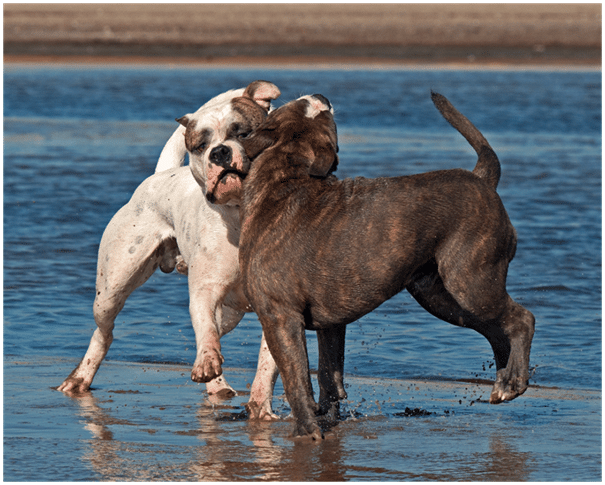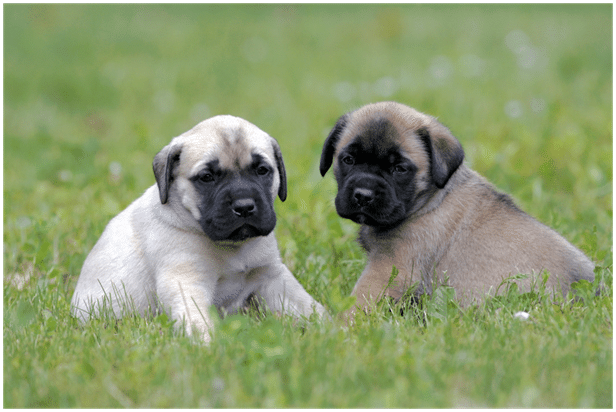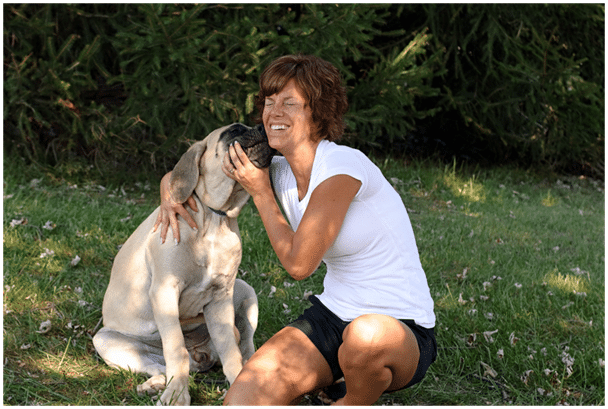When it comes to the English Mastiff, proper discipline is key to ensuring they become well-behaved members of the family. They are usually good dogs, but when they do get into trouble, knowing what action to take is essential. So, how do you discipline an English Mastiff?
In many cases, ensuring you do not give your dog any attention when they are misbehaving will do the trick. However, if this does not work, you can also speak to them in a serious tone and give clear commands such as “No” or “Sit”. These are important commands to teach your English Mastiff.
In this blog post, we’ll explore some effective techniques for disciplining your Mastiff, including positive reinforcement training and setting clear boundaries.
We’ll also discuss the importance of consistency and patience when it comes to training this loveable giant breed. Let’s get started!
How Does a Dog’s Size Affect How They are Disciplined?
The size of an English Mastiff can certainly have an impact on how to best discipline them. Many giant breeds, including English Mastiffs, may require different methods than smaller breeds
Known as gentle giants and the world’s largest breed of dog, the English Mastiff can weigh between 120-220 pounds. Because of their massive size, it’s important to use positive reinforcement methods when training them.
This means rewarding them for good behavior instead of punishing them for bad behavior.
The largest dog on record was an English Mastiff named Aicama Zorba, who weighed in at 343 pounds and stood 37 inches tall.
You can imagine that a dog of this size can be extremely dangerous if it develops an aggressive temperament! That’s why it’s so important to use positive reinforcement methods when training them.
How Do You Calm an English Mastiff?
English Mastiffs are adaptive learners and can be trained relatively easily. You need to remember patience and devote time to teaching them acceptable behavior.
English Mastiffs do not respond well to yelling or hitting as this is likely to result in further behavioral issues. They are more likely to learn calm, nonaggressive behavior with a patient, loving approach, along with consistent training.
Why is My English Mastiff So Aggressive?
Has your English Mastiff’s aggression appeared suddenly? If so, then it is best to pinpoint what is triggering this aggression. Pain is often a culprit for aggression in your dog which could be from arthritis, a bone fracture, or something internal.
There are also other illnesses that can cause an onset of aggression. Certain brain diseases or tumors may provide aggressive behavior in your English Mastiff. These are problems that are more common among older English Mastiffs.
Your English Mastiff may be displaying aggression due to fear. If your dog is a rescue animal then aggressive behavior could be a normal response to being abused, neglected, or have experienced a traumatic event.
Dogs at times feel a need to display their dominance, usually towards other dogs but this can occur with people. Dominance is not a personality trait so do not assume that this is a natural tendency of your English Mastiff. Dominance is usually exhibited due to circumstances.
How Do I Stop My English Mastiff from Being Aggressive?
You may have heard to “kill with kindness.” This same approach is useful in diminishing your English Mastiff’s aggression.
Treat them with kindness and affection, especially when they are younger as will be discussed more. Do not try to prove your dominance over your dog because this may worsen the problem.
In order to stop your English Mastiff’s aggression, you need to identify the reason it is occurring. Knowing the reason will often provide a solution to the problem such as needing regular exercise, love, socialization, or mental stimulation.
“Avoid punishing your dog for his aggression. This can make his behavior worse enticing more aggressive actions to prove his dominance.“
Seek the help of a professional. Your veterinarian may have health concerns and be able to diagnose something that is causing pain. Or you may want to pursue the aid of a professional dog trainer or a behaviorist who can offer solutions for your Mastiff.
How Do You Discipline a Dog That Won’t Listen?

At times, every dog needs correction to its behavior, and can seem impossible when your dog will not listen. Discipline does not always have to be a negative thing. It is a process that helps you convey to your dog what is allowed. Discipline can be humane while still being effective.
If your English Mastiff will not listen, then no longer give him your attention. When he misbehaves, avoid giving him any attention by taking his toys away and no longer playing.
You can even put your dog in time-out to show that you are not pleased with their behavior.
In order to discipline your English Mastiff, you will need to provide proper training.
Are English Mastiffs Easy to Train?
An English Mastiff typically enjoys pleasing their owners, making them an easier breed to train and discipline. They respond well to positive training where the sessions are short but also interesting.
This applies to crate training, potty training, and behavior training. Keeping all training sessions short and fun is the best approach for their limited attention spans.
Teach Obedience Training and Basic Commands
Your English Mastiff is very capable of learning basic commands such as sit, rollover, and stay. Each command is learned by incorporating the training into your daily training routines.
English Mastiffs learn to sit by you saying the word ‘Sit’ and pushing their rear down. It might take a little force and strength because your Mastiff is strong.
When he gets close to sitting you can praise him with commendation and a little treat. This is a good example of reward-based training and is very effective.
“Continue practicing this with repetition until he fully learns to sit upon command.“
It is adorable to see your English Mastiff roll over and can be fun for your dog too. Once your dog is lying down, begin saying the words ‘Roll Over’ while helping him roll over and holding a treat in your hand.
Do not let him get up but keep helping him until he understands the process.
Give him breaks without forcing him to learn, but your patience and enthusiasm will be sensed and reciprocated.
An English Mastiff can move on to learning to stay once he has mastered the command of ‘Sit.’
After you train your dog to sit, move back a few steps from him. If he begins to get up to walk towards you, say ‘No’ and put him back in the original position.
Start again and repeat the word ‘Stay’ as you move away from him.
Keep the distance for a few seconds and then give him a treat once you come back to his side. You can gradually increase the distance between you with the same process.
How to Train a Mastiff Puppy Not to Bite

Be consistent in training your puppy which will give you time to interact and play with him regularly. When your puppy bites in order to get your attention, simply tap on his nose and mention the word ‘No’ in a strong voice.
If the tap does not get your Mastiff puppy’s attention, then gently grab him by the nose and point at him while repeating “no” to him.
Consistently getting their attention will help them get the point.
After a few times of learning in this way, you can switch to just verbal corrections. Consistency will make sure that your puppy recognizes the verbal reminder to not bite.
You may also like – How To Potty Train an English Mastiff Puppy?
How Do I Get My English Mastiff to Stop Jumping?
Jumping is a natural greeting for dogs as you see when two dogs greet each other. When greeting people, your dog needs the training to know appropriate greetings. They are excited and demonstrate that by jumping.
Your first inclination might be to push your English Mastiff away but that can send mixed signals and your dog thinks that you are engaging in a game. When you get home ignore your dog until he calms down with all four paws on the floor.
Then you can say hi and touch him and he will learn that having all four paws on the floor will be rewarded with affection from you.
They need daily exercise which can include a long walk, run, or playing fetch in the backyard.
“A tired dog is a good dog and is less likely to want to jump up on you or anyone else. So, keeping the exercise regular is absolutely crucial!“
Also, be consistent with your rules and do not let anyone in the family, friends included, allow your English Mastiff to jump on them. Everyone needs to be on the same page with the rules or your dog will be confused.
If you are out and about and your dog starts to jump, immediately put him in a sit position and give him a treat. This will reinforce that good behavior is rewarded.
Jumping is a natural instinct for dogs but with patience and consistency, you can train your English Mastiff to stop jumping and have the well-mannered dog you always wanted.
Start Training English Mastiffs from a Young Age

While there are various training methods, you should begin initial training at an early age, as young as 8 – 10 weeks. Training times and progress will vary among puppies so stay patient and consistent.
Keep Training Sessions Short and Fun
English Mastiffs have a short attention span so keep the training sessions short. It is imperative to keep the sessions enjoyable with lots of praise and treats because this will motivate them to continue good behavior for these results.
Take note of which activities and rewards make your Mastiff happy and use these methods more frequently.
What are Good Training Treats for English Mastiffs?
A treat is a great way to communicate with your English Mastiff that you are pleased with their actions or behavior.
They need to be used in moderation and be nutritionally balanced. Choose treats that are dog appropriate, many developed by veterinarians offering guarantees of vitamins, proteins, and minerals.
Ensure English Mastiffs Are Socialized Early
The earlier you get your puppy used to be around people and other dogs the better.
Socialization will play a key role in your puppy being well-rounded and behaved as they grow older. Introducing them to other humans lets them get a sense of people that are safe.
What Age Does an English Mastiff Calm Down?
English Mastiffs remain in the puppy phase longer than other breeds. They may begin to calm down a bit by the age of a year and a half but will not be fully settled until closer to the age of three.
Do English Mastiffs Bark A lot?
The good news is your English Mastiff is a quiet breed of dog. They are easy to house-train and do not bark much unless given a reason. The English Mastiff is actually quiet in comparison to other dog breeds.
Final thoughts
It’s important to show your authority over an English Mastiff by issuing fair discipline. Without the right discipline, your dog can develop bad behaviors and become aggressive toward other people and dogs.
We hope this article has helped you learn how to discipline your English Mastiff the right way!


